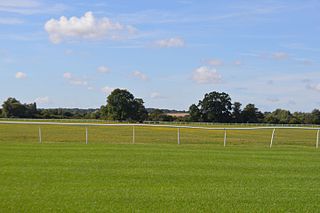| Site of Special Scientific Interest | |
 | |
| Area of Search | Northamptonshire |
|---|---|
| Grid reference | TF 017 042 [1] |
| Interest | Biological |
| Area | 5.0 hectares [1] |
| Notification | 1983 [1] |
| Location map | Magic Map |
Racecourse Farm Fields is a 5 hectare biological Site of Special Scientific Interest in Easton on the Hill in Northamptonshire. [1] [2]

A Site of Special Scientific Interest (SSSI) in Great Britain or an Area of Special Scientific Interest (ASSI) in the Isle of Man and Northern Ireland is a conservation designation denoting a protected area in the United Kingdom and Isle of Man. SSSI/ASSIs are the basic building block of site-based nature conservation legislation and most other legal nature/geological conservation designations in the United Kingdom are based upon them, including national nature reserves, Ramsar sites, Special Protection Areas, and Special Areas of Conservation. The acronym "SSSI" is often pronounced "triple-S I".

Easton on the Hill is a village and civil parish at the north eastern tip of the district of East Northamptonshire, England. The village is 59 miles east of Birmingham, 79 miles north of London and 12 miles northwest of Peterborough city centre. The population of the civil parish at the 2011 census was 1,015. The village, sited on the A43 road, is compact in form, with the older part of the village located north of the High Street. The parish extends from the River Welland in the north to the western end of RAF Wittering, in the northernmost part of Northamptonshire between Stamford and Collyweston.

Northamptonshire, archaically known as the County of Northampton, is a county in the East Midlands of England. In 2015 it had a population of 723,000. The county is administered by Northamptonshire County Council and by seven non-metropolitan district councils. It is known as "The Rose of the Shires".
This former quarry is grassland on Jurassic limestone. The flora is diverse, with over thirty flowering plant species in each square metre. There are several locally rare plants, such as dodder, autumn gentian, clustered bellflower and small scabious. The sward is kept short by grazing by sheep and cattle. [3]
The Jurassic period was a geologic period and system that spanned 56 million years from the end of the Triassic Period 201.3 million years ago (Mya) to the beginning of the Cretaceous Period 145 Mya. The Jurassic constitutes the middle period of the Mesozoic Era, also known as the Age of Reptiles. The start of the period was marked by the major Triassic–Jurassic extinction event. Two other extinction events occurred during the period: the Pliensbachian-Toarcian extinction in the Early Jurassic, and the Tithonian event at the end; however, neither event ranks among the "Big Five" mass extinctions.

Cuscuta epithymum is a parasitic plant assigned to the Cuscutaceae or Convolvulaceae family, depending on the taxonomy. It is red-pigmented, not being photosynthetically active. It has a filiform habit, like a group of yarns. Its leaves are very small, like flakes. Its flowers, disposed in little glomerules, have a white corolla, with the androecium welded to the corolla.
The site is private land with no public access.




















